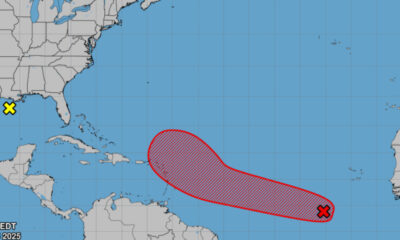Legal
Sinaloa Cartel leader ‘El Mayo’ Zambada pleads guilty, faces life in U.S. prison

Ismael “El Mayo” Zambada García, the 75-year-old co-founder of Mexico’s Sinaloa Cartel, has pleaded guilty in U.S. federal court to leading one of the world’s most powerful drug trafficking organizations, ensuring he will spend the rest of his life in an American prison, according to the Justice Department.
Zambada admitted on Monday to leading one of the world’s most violent drug trafficking organizations for decades, overseeing the import of cocaine, heroin, methamphetamine, and fentanyl into the United States while maintaining power through corruption and violence.
He is scheduled to be sentenced on January 13 and faces a mandatory life term. As part of his plea, he also agreed to a $15 billion forfeiture judgment.
The guilty plea ensured that both Zambada and his co-founder, Joaquín “El Chapo” Guzmán, “will live out the rest of their days in U.S. federal prison cells without the possibility of parole,” according to U.S. Attorney Joseph Nocella of the Eastern District of New York.
Prosecutors in Texas, Florida, and other districts said Zambada’s leadership fueled cartel wars, mass narcotics trafficking, kidnappings, and killings on both sides of the U.S.-Mexico border.
Zambada García’s rise to power began with the cartel’s formation in the late 1980s and spanned more than three decades, during which he remained one of Mexico’s most elusive drug lords.
The Sinaloa Cartel, previously known as the Mexican Federation, has for decades imported massive quantities of cocaine, heroin, methamphetamine, and fentanyl into the United States while laundering billions of dollars in drug proceeds back to Mexico. The cartel’s early operations centered on cocaine distribution through close coordination with South American suppliers and networks.
In the 2000s, as Colombian traffickers faced growing law enforcement pressure, they shifted away from direct distribution in the United States and allowed Mexican groups to buy into shipments at wholesale prices. This gave Mexican traffickers, including the Sinaloa Cartel, a far greater role in moving cocaine from Colombia into and across the United States.
Under Zambada García’s leadership following the arrest and extradition of Joaquín “El Chapo” Guzmán, the cartel expanded into fentanyl production, importing precursor chemicals from China and manufacturing thousands of kilograms in clandestine labs across Mexico for distribution in the United States.
Zambada operated with impunity at the highest levels of Mexico’s drug trade, shielding himself from arrest by paying bribes to government officials and law enforcement. Corrupt officials under his control protected cartel operatives and drug shipments as they moved across Mexico into the United States.
Witnesses, including those who testified in the trials of “El Chapo” and former Mexican security chief Genaro García Luna, described how corruption at every level sustained the cartel’s power: from local police who escorted drug convoys, to officials who tipped off the cartel about military operations, blocked capture attempts, and provided inside information on investigations.
In July 2024, Zambada was captured near El Paso, Texas, after allegedly being lured into a trap by Joaquín Guzmán López, one of El Chapo’s sons and a co-leader of the “Los Chapitos” faction of the Sinaloa Cartel. Both were taken into custody when their plane landed at Santa Teresa Airport, where U.S. authorities were waiting.
The move, described by Mexican drug war experts as a betrayal, is believed to have sparked a violent internal conflict between factions loyal to Zambada’s son and those aligned with the Guzmán brothers. The fighting has reportedly left more than 2,000 people dead and hundreds missing since the arrest of Zambada.

-

 US News7 days ago
US News7 days agoMedical helicopter crashes onto highway in Sacramento, California
-

 Entertainment6 days ago
Entertainment6 days agoReggaeton artist Zion hospitalized after ATV accident in Puerto Rico
-

 World4 days ago
World4 days agoGunmen open fire at concert in Peru, injuring members of popular band
-

 World1 week ago
World1 week agoTropical system likely to strengthen as it moves toward the Caribbean
-

 US News1 week ago
US News1 week agoJune tornado in North Dakota upgraded to EF5; first in U.S. since 2013
-

 Legal7 days ago
Legal7 days ago2 deputies wounded in Louisiana courthouse shooting
-

 Legal1 week ago
Legal1 week agoTeen arrested after stepfather found decapitated inside NYC home
-

 Legal5 days ago
Legal5 days ago4 found dead in San Francisco home in suspected murder-suicide




